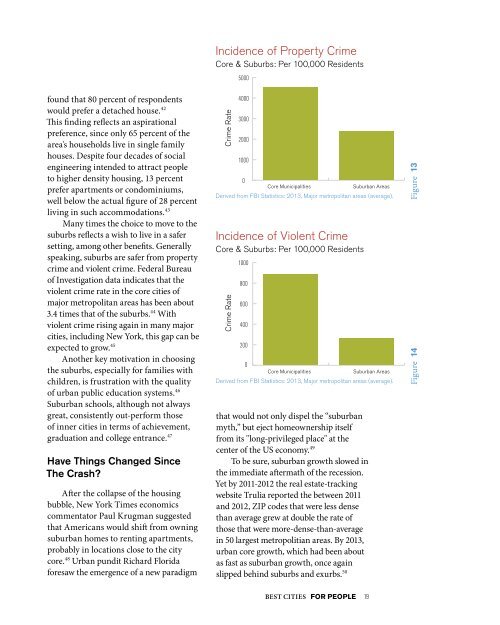FOR PEOPLE
1ONa2xt
1ONa2xt
You also want an ePaper? Increase the reach of your titles
YUMPU automatically turns print PDFs into web optimized ePapers that Google loves.
found that 80 percent of respondents<br />
would prefer a detached house. 42<br />
This finding reflects an aspirational<br />
preference, since only 65 percent of the<br />
area's households live in single family<br />
houses. Despite four decades of social<br />
engineering intended to attract people<br />
to higher density housing, 13 percent<br />
prefer apartments or condominiums,<br />
well below the actual figure of 28 percent<br />
living in such accommodations. 43<br />
Many times the choice to move to the<br />
suburbs reflects a wish to live in a safer<br />
setting, among other benefits. Generally<br />
speaking, suburbs are safer from property<br />
crime and violent crime. Federal Bureau<br />
of Investigation data indicates that the<br />
violent crime rate in the core cities of<br />
major metropolitan areas has been about<br />
3.4 times that of the suburbs. 44 With<br />
violent crime rising again in many major<br />
cities, including New York, this gap can be<br />
expected to grow. 45<br />
Another key motivation in choosing<br />
the suburbs, especially for families with<br />
children, is frustration with the quality<br />
of urban public education systems. 46<br />
Suburban schools, although not always<br />
great, consistently out-perform those<br />
of inner cities in terms of achievement,<br />
graduation and college entrance. 47<br />
Have Things Changed Since<br />
The Crash?<br />
After the collapse of the housing<br />
2.52.0<br />
bubble, New York Times economics<br />
commentator Paul Krugman suggested 2.01.5<br />
that Americans would shift from owning<br />
1.51.0<br />
suburban homes to renting apartments,<br />
probably in locations close to the city 1.0.5<br />
core. 48 Urban pundit Richard Florida<br />
0.50.0<br />
foresaw the emergence of a new paradigm<br />
Incidence of Property Crime<br />
Incidence of Property Crime<br />
Core & Suburbs: Per 100,000 Residents<br />
Core & Suburbs: Per 100,000 Residents<br />
Crime Rate<br />
Crime Rate<br />
5000<br />
4000<br />
4000<br />
3000<br />
3000<br />
2000<br />
2000<br />
1000<br />
1000<br />
0<br />
Core Municipalities<br />
Suburban Areas<br />
Derived from 0 FBI Statistics: 2013, Major metropolitan areas (average).<br />
Core Municipalities<br />
Suburban Areas<br />
Derived from FBI Statistics: 2013, Major metropolitan areas (average).<br />
Incidence of Violent Crime<br />
Incidence of Violent Crime<br />
Core & Suburbs: Per 100,000 Residents<br />
Crime Rate<br />
Crime Rate<br />
5000<br />
Core & Suburbs: Per 100,000 Residents<br />
1000<br />
1000<br />
800<br />
800<br />
600<br />
600<br />
400<br />
400<br />
200<br />
200<br />
0<br />
Core Municipalities<br />
Suburban Areas<br />
Derived from 0 FBI Statistics: 2013, Major metropolitan areas (average).<br />
Core Municipalities<br />
Suburban Areas<br />
Derived from FBI Statistics: 2013, Major metropolitan areas (average).<br />
Figure 15<br />
that would not only dispel the “suburban<br />
myth,” but eject homeownership itself<br />
from its "long-privileged place" at the<br />
center of the US economy. 49<br />
To be sure, suburban growth slowed in<br />
Figure 15<br />
the immediate aftermath of the recession.<br />
2.5 Yet by 2011-2012 the real estate-tracking<br />
website Trulia reported the between 2011<br />
and 2012, ZIP codes that were less dense<br />
than average grew at double the rate of<br />
those that were more-dense-than-average<br />
in 50 largest metropolitian areas. By 2013,<br />
urban core growth, which had been about<br />
as fast as suburban growth, once again<br />
slipped behind suburbs and exurbs. 50<br />
Figure<br />
Figure<br />
13<br />
13<br />
Figure<br />
Figure<br />
14<br />
14<br />
Exurbs are Growing Faster than Urban Core Again<br />
Exurbs are Growing Faster than Urban Core Again<br />
0.0 -0.5<br />
‘01–‘02 ‘04–‘05 ‘07–‘08 ‘10–‘11 ‘13–‘14<br />
-0.5<br />
BEST CITIES <strong>FOR</strong> <strong>PEOPLE</strong> 19<br />
Source: The ‘01–‘02 Brooklings Institution, U.S. ‘04–‘05 Census Bureau ‘07–‘08 ‘10–‘11 ‘13–‘14<br />
Source: The Brooklings Institution, U.S. Census Bureau<br />
Emerging Suburb<br />
Exurb<br />
Emerging Suburb<br />
Exurb<br />
Mature Suburb<br />
Urban Core<br />
Mature Suburb<br />
Urban Core




